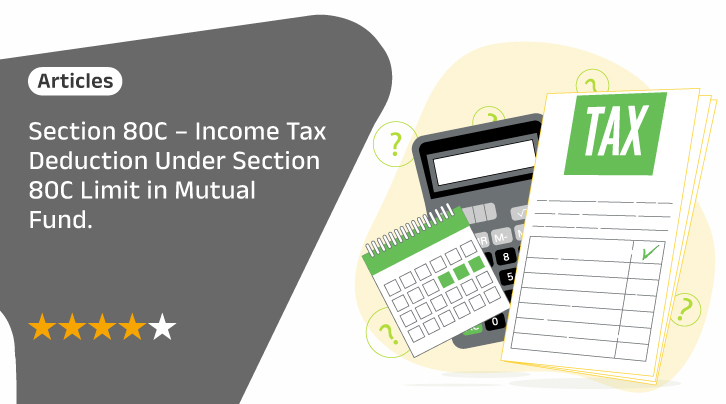Understanding the complex income tax ruling can be a major challenge for taxpayers who want to file their returns accurately and efficiently. One of the key components of this legislation is Section 80, which deals with tax deductions. To optimise tax savings, it is important to carefully assimilate the threshold criteria for various instruments, such as Public Provident Funds or mutual funds under 80C, and other opportunities for education, healthcare, and housing deductions.
Understand how to unlock Section 80 tax benefits through compliant investments and help them keep an accurate audit trail for claiming deductions.
Section 80 Deduction List
The Income Tax Act under Chapter VI-A generously consolidated an entire spectrum of investment avenues and expenditures deemed beneficial for channelling savings towards social development goals. Taxpayers sufficiently demonstrating valid usage of these tools attract permitted deductions, reducing aggregate tax liability by lowering the net taxable value base.
The Section 80 umbrella has specific features that make it stand out.
80C – Tax saver investments
80CCC – Annuity pension plans
80CCD – Central Government pension schemes
80D – Medical insurance payments
80E – Educational loan interest repayment
80EE – Additional home loan incentives
80EEA – Affordable housing incentives
80EEB – Electric vehicle purchase incentives
A structured approach around Section 80 delivers multi-dimensional dividends of stimulating savings, correcting social security gaps and improving disposable income simultaneously via tax liability pruning.
Section 80C – Deductions On Investments
Addressed under Section 80, sub-section 80C distinctly resonates most with income tax assessees given the wide prevalent utility of instruments covered coupled with generous ceilings permitting deductions up to ₹1.5 lakhs annually against tax payments.
Investments into any of the following registered plans qualify for availing 80C:
Public Provident Fund (PPF)
Employees Provident Fund
Sukanya Samriddhi Accounts
Life insurance premiums
Equity Linked Savings Schemes (ELSS)
National Savings Certificates
Tax Saving Bank/Post Office Fixed Deposits
5-year recurring deposits
The principal portion of home loans
Essentially, mechanisms promoting savings towards retirement, critical illness, or long-term capital growth goals reliably buffer income shocks. Hence, the legislative thrust encouraged citizens to commit surplus income into these vessels via Section 80C deductions for a maximum tax breakeven of ₹46,800 annually at a peak income tax slab of 30 per cent under the old tax regime . This is applicable to individual assessee below the age of 60 with taxable income above Rs 10 lakh but less than Rs 50 lakh. Assesses furnish valid documentary proof of 80C investment activity when filing returns to confirm eligibility.
Eligibility Of Deduction Under 80C Of Income Tax Act
All resident taxpayers are classified as eligible to claim permitted deductions under Section 80C towards approved financial instruments subject to adhering to prescribed rules. This encompasses:
Here are some of the 80C tax saving options an individual can opt for-
Investment options |
Minimum lock-in period |
Associated Risk |
ELSS |
3 years |
High |
NPS |
Till the investor reaches 60 years of age (retirement) |
High |
PPF |
15 Years |
Low |
NSC |
5 Years |
Low |
Sukanya Samriddhi |
8 Years |
Low |
Fixed Deposit |
5 Years |
Low |
Even secondary holders linked to eligible tax-saving investments qualify indirectly for deductions. Additionally, parents or kin deposits into saving plans meant for children's future also qualify, so the minimum holding span is 5 years.
However, some may face eligibility restrictions for certain instruments depending on specific entity statuses and PRE conditions. However, overall, Section 80C deductions praise extreme relevance for centring tax planning philosophies due to the sheer fiscal advantage rendered.
Equity-Linked Savings Scheme (ELSS)
ELSS, falling under Section 80C's exemption category up to its maximum limit (Rs.1.5 lakh), entails a mandatory 3-year lock-in period.
Sukanya Samriddhi Yojana (SSY)
Sukanya Samriddhi Yojana is a savings scheme tailored to fulfill the financial needs for a girl's education and marriage. Parents or legal guardians of a girl child (up to 10 years old) can initiate this account, while parents of two or more girls (twins included) can also invest in this plan.
The interest accrued from this investment scheme qualifies for tax exemption under Section 80C.
Infrastructure Bonds
Under Section 80C of the Income Tax Act, tax exemptions are granted on infrastructure bonds, with an investment threshold of Rs. 20,000 or more.The 80C deduction limit of Rs. 1.5 lakh remains applicable for these long-term secured bonds.
Click Here to know more about Infrastructure Fund
Tax Saving Fixed Deposit
Tax Saving FDs, available from banks and post offices, qualify for tax deduction under Section 80C. With a lock-in period of 5 years, these FDs offer a maximum tax exemption of Rs. 1.5 lakh on the principal amount. However, the returns from these instruments are subject to taxation.
Mutual Fund investments are subject to market risks, read all scheme related documents carefully.





 1800-270-7000
1800-270-7000




